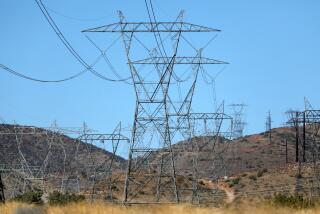Savings on Phaseout of Phone Tax a ‘Pittance’
- Share via
The House of Representatives last week voted to eliminate a phone tax--a feat almost worthy of the hoopla and self-congratulatory speeches that came with it.
Almost. First, removal of the century-old federal excise tax passed only the House and won’t be a done deal until it passes the Senate and is signed by President Clinton.
Second, the current plan would wipe out the tax gradually, so that it will not be completely gone from phone bills until October 2002.
The big-picture savings look great--eliminating about $5 billion paid yearly by phone customers, or more than $650 million by Californians. But down to a person, the savings is a pittance--especially when compared with the mess of mystery taxes, surcharges and fees that boost phone bills by several dollars each month.
A quick check of my own phone bill illustrates the problem: My local phone company, Pacific Bell, charges me 96 cents per month for the federal excise tax, and my long-distance carrier adds a 15-cent charge for the same tax.
I’ll be saving a whopping $1.11 per month once the federal excise tax is gone. Yawn. The other taxes and whatnot on my phone bill add up to $14.32 per month and may go higher under new proposals at the Federal Communications Commission.
Dial-an-Increase: Qwest Communications just instituted big rate hikes for some international calls on its 10-10-432 dial-around long-distance service, according to Richard Sayers, editor of 10-10PhoneRates.com, an Internet price-comparison site.
Dial-around services allow consumers to place long-distance calls on a phone company’s network on a per-call basis by dialing a special seven-digit access code.
Although heavily advertised versions of the 10-10 services boast of low rates, there often is a wide range in pricing--and lots of fine print, just as there is with subscription long-distance plans.
Qwest’s 10-10-432 service, for example, earlier this month raised the price for calls to some parts of Mexico to $1.33 per minute, up 375% from 28 cents a minute, according to Sayers. Calls to Germany with that service jumped to $1.39 per minute (plus a 6.85% fee), up from 25 cents.
See? It does pay to shop around. For dial-around service price comparisons that might fit your calling habits, check out https://www.10-10phonerates.com.
Calling Card Prices Rise: PacBell customers who use the phone company’s Worldwide Calling Card will pay more for local and local toll calls using the card. Starting June 2, PacBell will charge 25 cents per minute, up 67% from 15 cents. The per-use service charge on those calls will jump 40% to 35 cents, from 25 cents.
Heating Up DSL Competition: State regulators are preparing to reduce the built-in costs that competing phone companies must pay PacBell or GTE to set up a customer with digital subscriber line technology, a high-speed Internet access service.
Under a set of proposed interim rates, Covad Communications and other competitors will pay sharply lower prices to PacBell and GTE to set up residential DSL customers. The new prices go into effect Tuesday, while a review continues on permanent prices set to take effect by next spring.
Regulators and market watchers believe the interim pricing will put competitors on more equal footing with the incumbent phone companies and thus will spark more competition for residential DSL.
Currently, DSL rivals must buy an entire phone line from the phone company to provide DSL, instead of allowing the service to ride on the customer’s existing voice line (which is what PacBell and GTE do).
Under that system, competing DSL providers pay a significantly higher cost per line than incumbent phone companies PacBell and GTE. Faced with that cost differential, many DSL carriers have focused mainly on business customers, offering residential service selectively and at higher prices.
However, federal regulators passed “line-sharing” regulations that require incumbent phone companies to share its voice lines with DSL carriers.
There’s no guarantee, but consumers should soon see more action in residential DSL.
*
Elizabeth Douglass can be reached at elizabeth.douglass@latimes.com.
More to Read
Inside the business of entertainment
The Wide Shot brings you news, analysis and insights on everything from streaming wars to production — and what it all means for the future.
You may occasionally receive promotional content from the Los Angeles Times.










